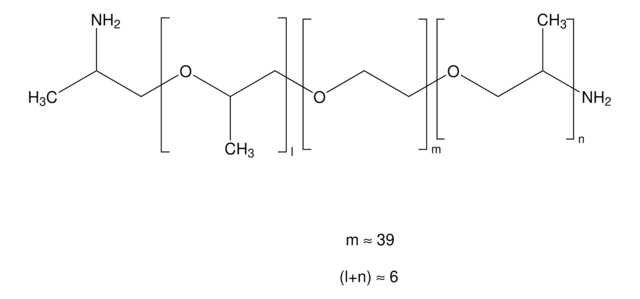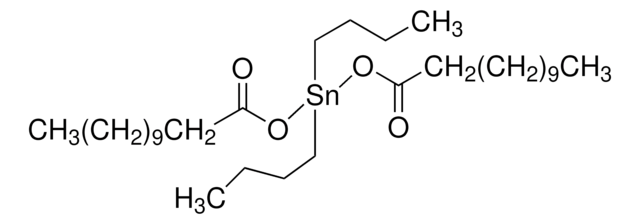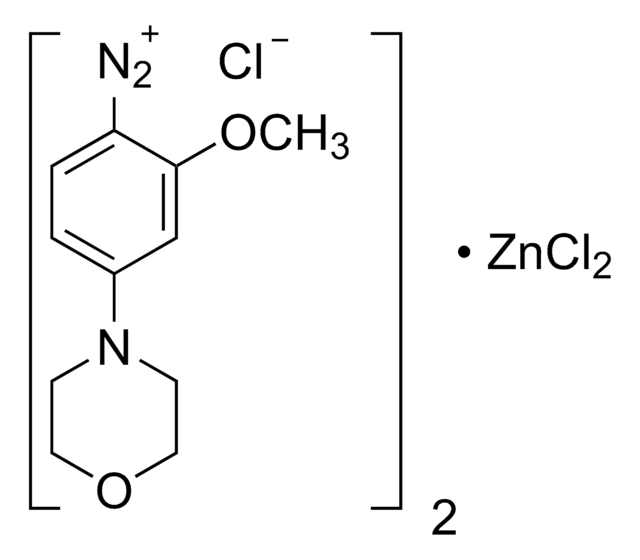202320
Poly(propylene glycol)
average Mn ~1,000
Synonym(s):
PPG, Poly(propylene oxide)
Sign Into View Organizational & Contract Pricing
All Photos(1)
About This Item
Linear Formula:
H[OCH(CH3)CH2]nOH
CAS Number:
MDL number:
UNSPSC Code:
12162002
PubChem Substance ID:
NACRES:
NA.23
vapor pressure:
<0.01 mmHg ( 20 °C)
Recommended Products
vapor density
>1 (vs air)
Quality Level
vapor pressure
<0.01 mmHg ( 20 °C)
mol wt
average Mn ~1,000
contains
130-190 ppm proprietary phenolic antioxidant
refractive index
n20/D 1.449
viscosity
150 cSt(25 °C)(lit.)
hydroxyl value
111 mg KOH/g
solubility
water: miscible (completely)
density
1.005 g/mL at 25 °C
SMILES string
CC(O)CO
InChI
1S/C6H14O3/c1-5(8)4-9-6(2)3-7/h5-8H,3-4H2,1-2H3
InChI key
DUFKCOQISQKSAV-UHFFFAOYSA-N
Looking for similar products? Visit Product Comparison Guide
Related Categories
General description
Poly(propylene glycol) (PPG) is a biocompatible polymer widely used as a precursor to fabricate biomedical materials. It is soluble in water at low temperatures and becomes insoluble at high temperatures.
Application
Poly(propylene glycol) can be used:
- As a precursor to synthesize multiblock thermo-responsive smart polymers for various biomedical applications. The presence of PPG is the main reason for the thermosensitivity of these polymers. For example, it can be used to synthesize poly(ester urethane)s.
- For the surface modification of sisal fiber to enhance nucleating ability.
Storage Class Code
10 - Combustible liquids
WGK
WGK 1
Flash Point(F)
445.0 °F - closed cup
Flash Point(C)
229.44 °C - closed cup
Personal Protective Equipment
dust mask type N95 (US), Eyeshields, Gloves
Choose from one of the most recent versions:
Already Own This Product?
Find documentation for the products that you have recently purchased in the Document Library.
Customers Also Viewed
Chang-Chin Wu et al.
Journal of biomedical materials research. Part B, Applied biomaterials, 105(8), 2232-2243 (2016-07-23)
Despite its common usage in vertebral augmentation procedures (VAPs), shortcomings of commercial polymethylmethacrylate (PMMA) still remain. Accordingly, injectable and biodegradable composite cements, which are composed of poly(propylene fumarate)/α-tricalcium/hydroxyapatite (PPF/α-TCP/HAP) and PPF/tetracalcium phosphate/dicalcium phosphate (PPF/TtCP/DCP), were developed. A porcine model was
Mohammed Taghi Zafarani-Moattar et al.
Biotechnology progress, 28(1), 146-156 (2011-09-29)
In this work, we proposed a novel aqueous biphasic system (ABS) composed of polypropylene glycol P400 (PPG P400) and hydrophilic ionic liquids (IL), 1-alkyl-3-methylimidazolium bromide (alkyl = ethyl or butyl), forming an upper polymer-rich phase and a lower IL-rich phase
Celeste R Brennecka et al.
World neurosurgery, 78(5), 469-480 (2011-11-29)
Current treatments for cerebral aneurysms are far from ideal. Platinum coils are prone to compaction, and currently used liquid embolics are delivered with angiotoxic agents. This work presents initial in vivo studies of a novel liquid-to-solid gelling polymer system (PPODA-QT)
John Texter et al.
Macromolecular rapid communications, 33(1), 69-74 (2011-12-03)
The controlled atom transfer radical polymerization of an ionic liquid, 1-(11-acryloylundecyl)-3-methyl imidazolium bromide (ILBr), from both ends of a telechelic poly(propylene oxide) (PPO) macroinitiator, end-functionalized with bromoisobutyryloyl is reported. The resulting highly water-soluble triblock, poly(ILBr-b-PO-b-ILBr) is multistimuli responsive. This new
Flávia Chiva Carvalho et al.
Journal of biomedical nanotechnology, 8(2), 280-289 (2012-04-21)
In the last few decades, nanotechnology has led to an advance in the development of topical drug delivery. Nanostructured drug delivery systems enable the compartmentalization of drugs in restricted environments, modifying the release profile and maintaining the required drug concentration
Our team of scientists has experience in all areas of research including Life Science, Material Science, Chemical Synthesis, Chromatography, Analytical and many others.
Contact Technical Service






